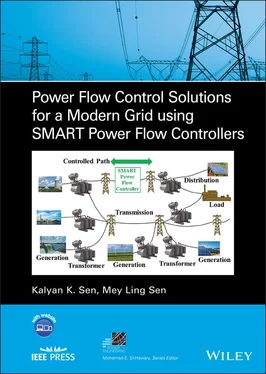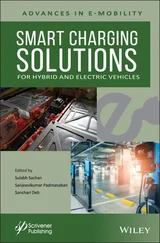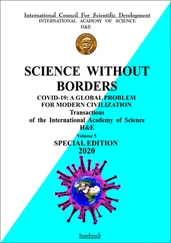Kalyan K. Sen - Power Flow Control Solutions for a Modern Grid Using SMART Power Flow Controllers
Здесь есть возможность читать онлайн «Kalyan K. Sen - Power Flow Control Solutions for a Modern Grid Using SMART Power Flow Controllers» — ознакомительный отрывок электронной книги совершенно бесплатно, а после прочтения отрывка купить полную версию. В некоторых случаях можно слушать аудио, скачать через торрент в формате fb2 и присутствует краткое содержание. Жанр: unrecognised, на английском языке. Описание произведения, (предисловие) а так же отзывы посетителей доступны на портале библиотеки ЛибКат.
- Название:Power Flow Control Solutions for a Modern Grid Using SMART Power Flow Controllers
- Автор:
- Жанр:
- Год:неизвестен
- ISBN:нет данных
- Рейтинг книги:5 / 5. Голосов: 1
-
Избранное:Добавить в избранное
- Отзывы:
-
Ваша оценка:
- 100
- 1
- 2
- 3
- 4
- 5
Power Flow Control Solutions for a Modern Grid Using SMART Power Flow Controllers: краткое содержание, описание и аннотация
Предлагаем к чтению аннотацию, описание, краткое содержание или предисловие (зависит от того, что написал сам автор книги «Power Flow Control Solutions for a Modern Grid Using SMART Power Flow Controllers»). Если вы не нашли необходимую информацию о книге — напишите в комментариях, мы постараемся отыскать её.
Power Flow Control Solutions for a Modern Grid using SMART Power Flow Controllers
Power Flow Control Solutions for a Modern Grid using SMART Power Flow Controllers
Power Flow Control Solutions for a Modern Grid Using SMART Power Flow Controllers — читать онлайн ознакомительный отрывок
Ниже представлен текст книги, разбитый по страницам. Система сохранения места последней прочитанной страницы, позволяет с удобством читать онлайн бесплатно книгу «Power Flow Control Solutions for a Modern Grid Using SMART Power Flow Controllers», без необходимости каждый раз заново искать на чём Вы остановились. Поставьте закладку, и сможете в любой момент перейти на страницу, на которой закончили чтение.
Интервал:
Закладка:
Today’s power grid has evolved into integration of inverter‐based, renewable‐sourced, electricity generation from solar and wind farms, which are intermittent in nature. Therefore, traditional steady‐state power flow controllers, such as series‐connected reactor/capacitor concepts, need to be updated with an improved dynamic response. Additionally, increasing installation of roof‐top solar and its integration into a low‐voltage distribution network has altered the traditional voltage profile in the distribution network and increased the need for a bidirectional power flow controller when the renewable generation is not available. Therefore, all available solutions need to be considered for future needs, which has led to the concept of SMART Controllers.
A considerable amount of effort has been put into modeling various controllers. Modeling is the only approach, before any hardware construction, for the verification of the performance of any concept. The book includes models of many controllers, developed using a freely available Electro‐Magnetic Transients Program (EMTP) software package.
The book is divided into six chapters and three appendices. Chapter 1presents the origin of power flow controllers and guides the reader to the selection process of a SMART Power Flow Controller (SPFC).
Chapter 2is for anyone who would like to become familiar with the subject. It discusses various topics of the book in simple electrical engineering terms and corroborates the theory with relevant mathematics. The characteristic equations of various power flow controllers, including their equivalent compensating impedances, are developed. Using these equations, a set of example problems is given, which gives a quick back‐of‐the‐envelope calculation results without much effort. A figure of merit, called Sen Index , is defined for all the Power Flow Controllers (PFCs).
Chapter 3presents the fundamentals of modeling in EMTP and explains the basic differences of modeling various PFCs, such as the Voltage‐Regulating Transformer (VRT), Phase Angle Regulator (PAR), Unified Power Flow Controller (UPFC), and Sen Transformer (ST). Following the Rough‐Order Magnitude (ROM) calculations performed in Chapter 2, using simple equations to characterize a power flow solution, the ROM results may need to be refined by employing the modeling techniques developed in Chapter 3. An example simulation of a series‐compensating voltage is shown to emulate a VRT, a PAR, and an Impedance Regulator (IR).
Chapter 4presents the transformer‐based PFCs and gives some baseline examples for comparison with other PFCs in the following chapters. It is shown how a VRT and a PAR may be modeled by using a series‐compensating voltage.
Chapter 5presents some early PFCs that use mechanical switches and set some baselines for comparison in the following chapters. It is shown how to model a virtual impedance that is equivalent to shunt‐connected and/or series‐connected inductive and/or capacitive compensators.
Chapter 6presents the evolution of an ST and its wide variety of applications. The most up‐to‐date advancements in ST are described in this chapter. This includes various forms of two‐core designs. Also included is a new factory‐test method under full power.
Appendix Adescribes the operation of various items, such as (1) three‐phase balanced and unbalanced voltage, current, and power; (2) symmetrical components; (3) d‐q transformation; and (4) Fourier analysis. The reader will find it useful to see the industry techniques and the relevance of the theory and applications.
Appendix Bpresents the power flow control equations in a lossy line and compares the derived results from those in Chapter 2for lossless lines. Simpler versions of these equations are derived in Chapter 2, considering the line resistance ( R ) is zero. These examples will be used as future references for those involved with PFCs. For the readers to recognize the importance of the equations and example solutions presented in Chapter 2, a list of all the “Examples” is placed at the end of Appendix B. Using the information received from Supervisory Control And Data Acquisition (SCADA) about the sending‐ and receiving‐end voltages ( V sand V r) and active and reactive power flows ( P rand Q r), other power flow variables, such as the power angle ( δ ), can be calculated for a known line impedance ( Z= R + jX ).
Appendix Cpresents a load flow study of the Chilean network, integrated with Sen Transformer, performed by Siemens PTI and sponsored by New York Power Authority.
Pittsburgh, Pennsylvania
Kalyan K. Sen
Mey Ling Sen
Acknowledgments
We both would like to thank our former colleagues at Westinghouse where the pioneering development of FACTS controllers started in 1990 under the technical leadership of Dr. L. Gyugyi. We are very grateful for all those who dedicated their time to review the manuscript thoroughly and provide valuable feedback. Special gratitude goes to Mr. R. Alexander, Dr. S. Behzadirafi, Mr. J. M. DeSalvo, Dr. M. Haj‐Maharsi, Dr. A. J, F. Keri, Dr. T. Manna, Mr. A. Parsotam, Mr. G. Pedrick, Dr. B. Shperling, and Mr. R. Subramanian. We acknowledge the continuous effort to promote Sen Transformer – a SMART Power Flow Controller technology by Dr. S. Behzadirafi, Mr. A. Ettlinger, Dr. B. Fardanesh, and Mr. G. Pedrick of New York Power Authority, late Mr. M. Henderson of New England ISO, Mr. A. Parsotam of Newcastle, New South Wales, Australia, Prof. V. Dinavahi of University of Alberta, Prof. R. Gokaraju of University of Saskatchewan, Mr. R. Alexander, and Mr. J. M. DeSalvo. We thank American Public Power Association and Abby Anaday on Unsplash for using their respective photos of Hydropower and Windmill on the coverpage. After performing decades of research on various power flow control technologies, we feel that “the more we learn, the more we realize how little we know.” We appreciate feedback from the readers. Our email addresses are senkk@ieee.org and senml@ieee.org, respectively.
K.K.S.
M.L.S.
I would like to acknowledge my three professors, in particular, late S. K. Dutta of Jadavpur University for teaching me the basics of power electronics – a new and upcoming subject during 1970–1980, Dr. P. K. Ray of Tuskegee University for giving me a thorough training on how to conduct a basic research, and Dr. A. E. Emanuel of Worcester Polytechnic Institute for perfecting the mold as my PhD thesis Advisor.
Very special thanks go to my two Westinghouse mentors – late T. Heinrich and late M. Brennen whose insights in power electronics were unparalleled. Proper thanks go to Dr. L. Gyugyi who convinced me to change my job from academia to industry, a change that I never regretted. He is the inspiration for my life‐long passion to develop power flow control technologies. I feel fortunate to have worked in the development of FACTS products under his supervision.
Throughout my tenure at Westinghouse Science & Technology Center in Pittsburgh, I had a rare opportunity of working with extraordinary people from all over the world. Not only were they a fine class of engineers, they also had hobbies that could be considered as careers in their own rights. During the long hours of commissioning of the world’s first UPFC in Kentucky and a STATCOM in Texas, and the TNA test in Montreal, the team of engineers kept everyone amused with their life stories. I thank the fine colleagues at the Tennessee Valley Authority, American Electric Power, New York Power Authority, Bonneville Power Administration, Western Area Power Administration, and the Electric Power Research Institute.
K.K.S.
About the Companion Website
Интервал:
Закладка:
Похожие книги на «Power Flow Control Solutions for a Modern Grid Using SMART Power Flow Controllers»
Представляем Вашему вниманию похожие книги на «Power Flow Control Solutions for a Modern Grid Using SMART Power Flow Controllers» списком для выбора. Мы отобрали схожую по названию и смыслу литературу в надежде предоставить читателям больше вариантов отыскать новые, интересные, ещё непрочитанные произведения.
Обсуждение, отзывы о книге «Power Flow Control Solutions for a Modern Grid Using SMART Power Flow Controllers» и просто собственные мнения читателей. Оставьте ваши комментарии, напишите, что Вы думаете о произведении, его смысле или главных героях. Укажите что конкретно понравилось, а что нет, и почему Вы так считаете.












